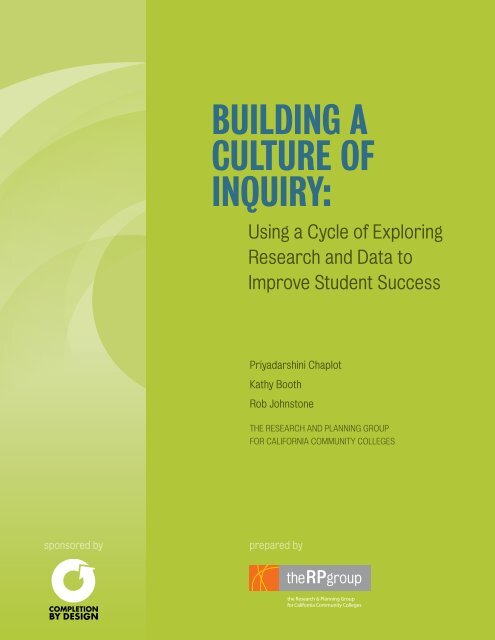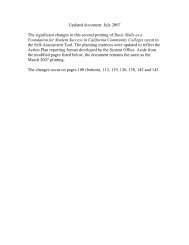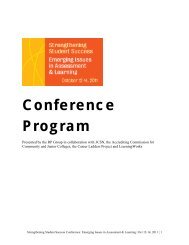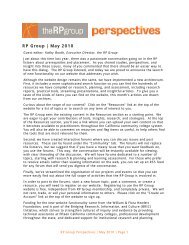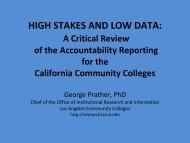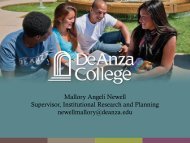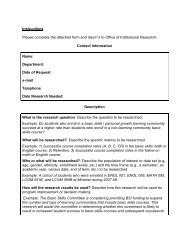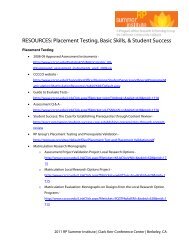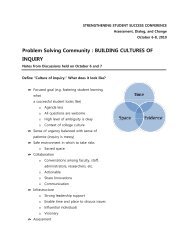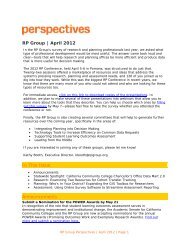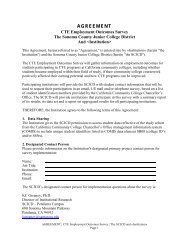Building a culture of inquiry: - The RP Group
Building a culture of inquiry: - The RP Group
Building a culture of inquiry: - The RP Group
Create successful ePaper yourself
Turn your PDF publications into a flip-book with our unique Google optimized e-Paper software.
<strong>Building</strong> a<strong>culture</strong> <strong>of</strong><strong>inquiry</strong>:Using a Cycle <strong>of</strong> ExploringResearch and Data toImprove Student SuccessPriyadarshini ChaplotKathy BoothRob Johnstone<strong>The</strong> Research and Planning <strong>Group</strong>for California Community Collegessponsored byprepared bythe<strong>RP</strong>groupthe Research & Planning <strong>Group</strong>for California Community Colleges
About the AuthorsPriyadarshini Chaplot is the director <strong>of</strong> pr<strong>of</strong>essional development and a seniorresearcher at the <strong>RP</strong> <strong>Group</strong>. She dually leads the design, implementation and evaluation<strong>of</strong> pr<strong>of</strong>essional development opportunities that engage a variety <strong>of</strong> community collegepractitioners and actively participates in research projects on applied <strong>inquiry</strong> and studentsupport. Previously, Ms. Chaplot served as the educational research assessment analyst at Mt.San Antonio College, where she partnered with faculty, staff and administrators to develop andassess student learning outcomes and connect these research findings to planning efforts inorder to improve student success. Additionally, she served as an instructor teaching math andEnglish in the Adult Diploma Program. Working in the California community college system forsix years and in the field <strong>of</strong> education for over a decade, she is passionate about practitionerengagement, college reform and student success.Kathy Booth is the executive director <strong>of</strong> the <strong>RP</strong> <strong>Group</strong>. Her work in the California communitycollege system has included facilitating statewide meetings, creating practitioner-focusedbriefs on community college reform strategies, and envisioning pr<strong>of</strong>essional developmentapproaches that encourage practitioners to integrate research into institutional improvementefforts. Before joining the <strong>RP</strong> <strong>Group</strong> she worked with the @ONE Project, where she manageda fellowship program that enabled faculty to conduct research in their own classrooms anddeveloped multi-day trainings on the use <strong>of</strong> technology to improve student success. Prior tothis, Ms. Booth spent a decade working in the nonpr<strong>of</strong>it sector including overseeing the nation’slargest management and technology training program for nonpr<strong>of</strong>its, conducting researchon successful collaborations between artists and community development organizations,facilitating community planning processes, and leading organizational assessments. She is theauthor <strong>of</strong> two handbooks on building collaborations to further social change.Rob Johnstone leads the <strong>RP</strong> <strong>Group</strong>’s national programs and provides strategic consulting& technical assistance that help community colleges across the country improve studentcompletion outcomes. Through his work on projects such as the <strong>RP</strong> <strong>Group</strong>’s BridgingResearch, Information and Culture (BRIC) Initiative, the Gates Foundation’s Completion byDesign initiative, and the Aspen Prize for Community College Excellence, he has catalyzedthe evolution <strong>of</strong> college <strong>culture</strong>s that use <strong>inquiry</strong>, research and evidence at the practitionerlevel to create the conditions for change. Dr. Johnstone has over a decade <strong>of</strong> experience asa Director, Dean, and Vice President <strong>of</strong> Instruction in community colleges in California, andbrings a practitioner’s experience and perspective to bear on complex structural issues.Dr. Johnstone also served as a strategic consultant in industry prior to his work in highereducation, where he specialized in working with companies on how to utilize information andanalytics to more purposefully manage customer relationships.<strong>Building</strong> a <strong>culture</strong> <strong>of</strong> Inquiry: Using a Cycle <strong>of</strong> Exploring Research and Data to Improve Student Success 2
AcknowledgementsThis suite <strong>of</strong> <strong>inquiry</strong> guides emerges fromcollaborations between the Research andPlanning <strong>Group</strong> for California CommunityColleges (<strong>RP</strong> <strong>Group</strong>) team and many organizations and individuals through the Completion byDesign initiative. We thank the Bill and Melinda Gates Foundation for supporting the development<strong>of</strong> these guides, and specifically, Suzanne Walsh and Jill Wohlford for their guidance.<strong>The</strong> content within this guide has been developed with and by a host <strong>of</strong> thought partners.We are grateful for their thought capital, collegiality and continued drive to improve the lives<strong>of</strong> our community college students, and the local, statewide, and national economies that thecommunity college completers will serve. Our thought partners include:• Community College Research Center (CCRC)• Public Agenda• WestEd• Jobs for the Future• JBL AssociatesWe would like to recognize and thank the following group <strong>of</strong> community college practitioners forreviewing the <strong>inquiry</strong> guides and providing insightful feedback:• Marcy Alancraig, SLO Coordinator and English Faculty, Cabrillo College• Julianna Barnes, Vice President <strong>of</strong> Student Services, San Diego Mesa College• Tess Hansen, English Faculty, Foothill College• Chialin Hsieh, Director <strong>of</strong> Planning, Research and Institutional Effectiveness, College <strong>of</strong> Marin• Daniel Miramontez, Research and Planning Analyst, San Diego Community College District• Rose Myers, Vice President Emerita <strong>of</strong> Student Development, Foothill College• Ian Walton, Math Faculty Emeritus, Mission College and Past President, Academic Senatefor California Community CollegesAdditionally, the <strong>inquiry</strong> guides share relevant findings and insights from several projectsconducted or supported by the <strong>RP</strong> <strong>Group</strong>. We thank the Aspen Institute, the William and FloraHewlett Foundation, the Kresge Foundation and the James Irvine Foundation as well as theirprogram <strong>of</strong>ficers for enabling these efforts. <strong>The</strong>se projects include:• <strong>The</strong> Aspen Prize for Community College Excellence - www.aspeninstitute.org/policywork/aspen-prize/about• Bridging Research, Information & Cultures (BRIC) – www.rpgroup.org/projects/BRIC.html• Student Support (Re)Defined - www.rpgroup.org/projects/student-support• Hewlett Leaders in Student Success - www.rpgroup.org/hewlettleadersinstudentsuccessWhile this work has been supported by our partners, projects, and funders , these guidesrepresent the <strong>RP</strong> <strong>Group</strong>’s interpretation <strong>of</strong> these issues. Questions about these guides should bedirected to Dr. Rob Johnstone at rjohnstone@rpgroup.org or Priyadarshini Chaplot at pchaplot@rpgroup.org <strong>of</strong> the <strong>RP</strong> <strong>Group</strong>.<strong>Building</strong> a <strong>culture</strong> <strong>of</strong> Inquiry: Using a Cycle <strong>of</strong> Exploring Research and Data to Improve Student Success 3
<strong>Building</strong> a<strong>culture</strong> <strong>of</strong><strong>inquiry</strong>:Using a Cycle <strong>of</strong> ExploringResearch and Data toImprove Student SuccessIntroductionConsider the following scenario—one common in many colleges across the country.Imagine that last year, your institution launched a learning community initiative withhopes <strong>of</strong> improving your students’ engagement and success. Working in collaborationwith other counselors and faculty members from various disciplines, you establishedand implemented a series <strong>of</strong> developmental education courses linked with disciplinebased<strong>of</strong>ferings. One year, many pr<strong>of</strong>essional development activities and several studentparticipants later, you are all now gathered to review the potential impact <strong>of</strong> this effort.Questions are swirling. Did students in learning communities have higher rates <strong>of</strong>completing the developmental education courses as well as the sequence? Was theregreater persistence from term to term? Did they earn more credentials? How did they fareaccording to the courses’ student learning outcomes?Though there are many domains that can be investigated concerning studentperformance and success, preliminary findings <strong>of</strong> such high-impact studies seem to focuson the bottom line—whether the effort made an overall difference or not. In our scenario,early figures on the impact <strong>of</strong> the learning communities have come in lower than whatyou and the rest <strong>of</strong> your college expected. <strong>The</strong>re is, at best, a marginal improvement instudent performance. Upon hearing this discouraging news, some in the room voice theneed to reconsider continuing the learning communities, citing the data as well as thedifficulty in sustaining and institutionalizing these efforts. Others quietly nod their heads.You keenly remember the amount <strong>of</strong> promise and effort that went into this endeavor andfeel uncomfortable disbanding the initiative. So, what do you do? How do you, as a team,review the data and make sense <strong>of</strong> the implications? How to do you use that informationto inform your next steps?This <strong>inquiry</strong> guide aims to explore situations such as this one and <strong>of</strong>fer a process <strong>of</strong><strong>inquiry</strong> that can help colleges make high-impact decisions.<strong>Building</strong> a <strong>culture</strong> <strong>of</strong> Inquiry: Using a Cycle <strong>of</strong> Exploring Research and Data to Improve Student Success 4
What is Completion by Design?Completion by Design is a five-year initiative sponsored by theBill & Melinda Gates Foundation. Through this project, cadres <strong>of</strong>community colleges within three states–Florida, North Carolinaand Ohio–are working to increase the ability <strong>of</strong> students tosucceed by developing coherent pathways <strong>of</strong> study. Completionby Design has identified three key completion goals on which t<strong>of</strong>ocus: earning certificates and degrees, transferring to four-yearinstitutions and raising their value in the labor market.<strong>The</strong> aim <strong>of</strong> the initiative is to raise community college completion rates for largenumbers <strong>of</strong> students while containing college costs, maintaining open accessand ensuring the quality <strong>of</strong> college programs and credentials. <strong>The</strong> Completionby Design initiative provides each cadre with grants as well as a broad range <strong>of</strong>technical assistance and other supports. <strong>The</strong>se supports include assistance in datagathering and use; cost and productivity gains; research about implementationoptions; change management including policy change; and faculty engagement.In addition to monetary funds to catalyze implementation <strong>of</strong> the proposals fromthe planning year, these colleges are receiving strategic support within theirown cadre from a managing partner as well as focused technical assistance froma host <strong>of</strong> national partners. This support includes on-campus presentations,workshops and within-cadre convenings from national assistance partners suchas the <strong>RP</strong> <strong>Group</strong>, Public Agenda and Columbia University’s Community CollegeResearch Center (CCRC). In addition, the national assistance partners work withthe Foundation as well as each other to engage colleges in the implementationstrategy while maintaining a focus on practitioner engagement. This engagementfocuses on such issues as exploring and integrating research evidence into strategy,engaging in difficult conversations around the implications <strong>of</strong> implementation andempowering practitioners to visualize the changes in their own work as a result<strong>of</strong> the implementation. Equipped with such varied support, these cadres workcollaboratively to review, rethink and ultimately, redesign their organizationalsystems to raise student completion rates. Instrumental in this redesign processis the act <strong>of</strong> student-focused <strong>inquiry</strong> that the cadres will use to fundamentallyrethink their systems. This activity requires administrators, faculty, student servicespr<strong>of</strong>essionals and students to:••••••••••Construct thoughtful questions to better understand the student experienceFace realities about the status quoCollect and examining various types <strong>of</strong> dataInterpret the evidence among colleaguesCollectively engage in passionate discourse on how to interpret thisevidence and use it to inform action<strong>Building</strong> a <strong>culture</strong> <strong>of</strong> Inquiry: Using a Cycle <strong>of</strong> Exploring Research and Data to Improve Student Success 5
In completing each <strong>of</strong> these critical steps, colleges are evolving from institutionsthat work with <strong>culture</strong>s <strong>of</strong> evidence to institutions that work with <strong>culture</strong>s <strong>of</strong><strong>inquiry</strong>. 1 In order to bring these concepts to other colleges around the country,a set <strong>of</strong> four <strong>inquiry</strong> guides documenting these approaches and insights hasbeen developed:<strong>Building</strong> a Culture <strong>of</strong> Inquiry: Using a Cycle <strong>of</strong>Exploring Research and Data to Improve StudentSuccess explores the concept <strong>of</strong> a <strong>culture</strong> <strong>of</strong> <strong>inquiry</strong>and introduces a framework to strengthen a college’sability to better use research and evidence to informimprovement efforts.Understanding the Student Experience Throughthe Loss/Momentum Framework: Clearing thePath to Completion introduces an approach toexamining students’ own experiences at communitycollege, identifying factors that catalyze and impedestudent progress and using these insights to addressopportunities to improve student outcomes.<strong>The</strong> Nuances <strong>of</strong> Completion: Improving StudentOutcomes by Unpacking the Numbers examinesthe hidden complexity <strong>of</strong> completion outcome dataand <strong>of</strong>fers an approach to teasing out the complexfactors that affect student completion in order toboost student success.Principles <strong>of</strong> Redesign: Promising Approaches toTransforming Student Outcomes presents eightcore ideas to help colleges address the fundamentalchallenges to student success.<strong>Building</strong> a <strong>culture</strong> <strong>of</strong> Inquiry: Using a Cycle <strong>of</strong> Exploring Research and Data to Improve Student Success 6
How Can You Use This Guide?This <strong>inquiry</strong> guide introduces a framework for building a college’s <strong>culture</strong> <strong>of</strong> <strong>inquiry</strong>. It isintended for practitioners and leaders interested in advancing the institution’s ability tomake better use <strong>of</strong> research and evidence to inform improvement efforts.<strong>The</strong> guide begins with a brief discussion <strong>of</strong> why information alone is not sufficient todrive improvement efforts. <strong>The</strong>n, it characterizes a <strong>culture</strong> <strong>of</strong> <strong>inquiry</strong> and what roleit plays in improving student outcomes. Finally, it <strong>of</strong>fers a framework to strengthena <strong>culture</strong> <strong>of</strong> <strong>inquiry</strong> at the institution. Discussion questions, examples and relevantresources are embedded to promote reflection, dialog and further exploration.What Do Practitioners Say about Data?Over the past few years, community colleges have made stridesin building <strong>culture</strong>s <strong>of</strong> data and evidence on their campuses.Through processes like program review, student learningoutcomes, accountability reports and planning documents,facts and figures about various aspects <strong>of</strong> studentoutcomes and institutional performance are moreabundant than ever. In many cases, such data revolvearound institutional-level metrics such as productivity,efficiency, retention, graduation and transfer rates,which are all important elements to measure.Additionalinformation aboutCompletion by Design and otherrelevant studies can be found atwww.completionbydesign.organd in the list <strong>of</strong> AdditionalResources at the end<strong>of</strong> this guide.<strong>The</strong> most challenging next step is to move from a placewhere a lot <strong>of</strong> data is simply made available to a placewhere these data and analytics are used to produce insightand derive meaning that will ultimately help institutionstransform their structures, approaches and student experiences toimprove outcomes. While colleges are successfully tracking a wide variety <strong>of</strong>metrics, many have found it challenging to take this next step <strong>of</strong> analyzing the evidenceand using it to inform decision making. In other words, colleges tend to be data-rich butinsight-poor.This challenge <strong>of</strong> “data-rich but insight-poor” was documented in a 2009 survey 1 <strong>of</strong>community college practitioners conducted by the Research and Planning <strong>Group</strong> forCalifornia Community Colleges (<strong>RP</strong> <strong>Group</strong>). One hundred and ten California communitycolleges responded to questions about what types <strong>of</strong> information were available, whohad access to this information and how the information was used to inform action.Perspectives were gathered from high-level administrators such as chief executive <strong>of</strong>ficers,chief instructional <strong>of</strong>ficers, chief student services <strong>of</strong>ficers, chief business <strong>of</strong>ficers andinstitutional researchers, as well as on-the-ground leadership such as academic senatepresidents, developmental education coordinators and student learning outcomescoordinators. <strong>The</strong> survey revealed an interesting finding: the closer practitioners werein contact with students, the less likely they were to have access to or use data.<strong>Building</strong> a <strong>culture</strong> <strong>of</strong> Inquiry: Using a Cycle <strong>of</strong> Exploring Research and Data to Improve Student Success 7
This is not surprising given that most <strong>of</strong> the standard college reports are designed tosupport administrative decisions such as which courses to schedule, identify if theinstitution is meeting accreditation standards or to document overall graduation andtransfer rates. While such metrics are fundamental to assessing the effectiveness <strong>of</strong>an institution, it is difficult to meaningfully incorporate institutional-level data intodiscussions <strong>of</strong> student learning and progress, especially among faculty and studentservices pr<strong>of</strong>essionals who are directly or indirectly supporting students. Additionalresearch and data, such as attainment <strong>of</strong> intermediate milestones, student perspectives,employer needs and labor market outcomes, combined with faculty and student servicesexpertise, may be able to effect greater action. In order to support stronger decisionmaking, colleges need to look beyond their institutional databases.<strong>The</strong> <strong>RP</strong> <strong>Group</strong> survey also found that most efforts to understand and act on informationwere concentrated at the top <strong>of</strong> the organization. However, practitioners at all levels <strong>of</strong>the colleges noted that there was not enough time or space to engage in data analysis oraction. When asked how to more effectively use data, community colleges prioritizedcreating opportunities to interpret and make use <strong>of</strong> the information. In the eyes <strong>of</strong> theseinstitutions, having access to data is just the first step for instigating improvement efforts, butit is not sufficient—in essence, “Data alone don’t drive decisions.”Discuss1.2.3.4.How are data and information used on your campus?What types <strong>of</strong> information does your college currently collect?How does your institution tend to use that information?Who is most likely to work with this information?<strong>Building</strong> a <strong>culture</strong> <strong>of</strong> Inquiry: Using a Cycle <strong>of</strong> Exploring Research and Data to Improve Student Success 8
What Is a Culture <strong>of</strong> Inquiry?Routinely collecting information helps to build a <strong>culture</strong> <strong>of</strong> evidence, something thatmany community colleges have successfully done. Actively exploring and scrutinizingthat information to understand its meaning and implications for practice can help tocreate a <strong>culture</strong> <strong>of</strong> <strong>inquiry</strong>. <strong>The</strong> catalyst for the concept <strong>of</strong> a <strong>culture</strong> <strong>of</strong> <strong>inquiry</strong> was the2005 Lumina Foundation for Education research report by Alicia Dowd titled, “DataDon’t Drive: <strong>Building</strong> a Practitioner-Driven Culture <strong>of</strong> Inquiry to Assess CommunityCollege Performance.” 2 <strong>The</strong> <strong>RP</strong> <strong>Group</strong> expands on that concept and characterizes a<strong>culture</strong> <strong>of</strong> <strong>inquiry</strong> 3 as:••••••••••Leveraging a wide range <strong>of</strong> relevant data to support deeper learning, includingbringing in practitioner and student perspectivesProviding frequent opportunities for individuals to explore data together andengage in an open, honest and collaborative dialog on strengthening the institutionand student outcomesCreating a safe environment for exploration, where information is not used toshame or punish and mistakes are seen as learning opportunitiesEmphasizing the collaborative and collective development <strong>of</strong> action stepsUtilizing an ongoing process <strong>of</strong> exploration to expand a college’s collectiveknowledge base to better understand how to strengthen conditions for increasedlevels <strong>of</strong> student successWhen a college is undertaking a broader reform effort, a <strong>culture</strong> <strong>of</strong> <strong>inquiry</strong> can be used todefine a framework for action, cultivate the engagement <strong>of</strong> a broad range <strong>of</strong> practitionersand identify discrete action steps at various levels <strong>of</strong> the institution. For example, acollege could focus campus-wide <strong>inquiry</strong> on narrowing equity gaps or a departmentcould strategize curriculum redesign and/or student support to strengthen students’ability to complete a credential.Why Is a Culture <strong>of</strong> Inquiry Important?<strong>Building</strong> and sustaining a <strong>culture</strong> <strong>of</strong> <strong>inquiry</strong> is crucial in our current community collegeenvironment. With shrinking higher education budgets and an increased focus onaccountability, having a thorough understanding <strong>of</strong> students’ journeys through collegeis critical to enable both students and colleges to achieve their goals. Furthermore,practitioners require a better understanding <strong>of</strong> the needs and experiences <strong>of</strong> specificpopulations to ensure that community colleges retain their mission <strong>of</strong> promoting opportunityfor all students. African-American, Hispanic and Native American students have lower successrates than whites and Asian-Americans. Additionally, growing poverty rates make it vital forstudents to complete college efficiently and enter the job market with a minimum amount<strong>of</strong> debt. Focusing institutional efforts, using evidence and engaging in ongoing dialoguewill enable colleges to better understand how to change practices and strategically allocateresources in this context. Given these circumstances, building and sustaining a <strong>culture</strong> <strong>of</strong><strong>inquiry</strong> has become essential in any effort to improve student learning outcomes.<strong>Building</strong> a <strong>culture</strong> <strong>of</strong> Inquiry: Using a Cycle <strong>of</strong> Exploring Research and Data to Improve Student Success 9
Collecting data on student performance and institutional progress on an ongoing basis isthe foundation for improvement, but these data alone will not lead to answers. This workneeds to marry evidence with insight for three reasons:1.2.3.Weaving data with the perspectives and deep subject-matter expertise <strong>of</strong>front-line pr<strong>of</strong>essionals such as student services pr<strong>of</strong>essionals and faculty willstrengthen understanding about what is happening and what needs tohappen to advance student success. <strong>The</strong>ir daily interaction with studentscan help give meaning and nuance to the numbers.By including practitioners in the process <strong>of</strong> defining problems and solutions,improvement efforts will become truly institution-wide. Rather thanfocusing effort on building buy-in for top-down approaches, cultivating a<strong>culture</strong> <strong>of</strong> <strong>inquiry</strong> means that those who work most closely with students aremore likely to integrate new strategies into their daily practice and generatenew ideas for how to make these strategies more effective.Engaging the college community in examining what works and where tomake improvements can reignite optimism and excitement. In a time whencolleges have had to absorb demoralizing cuts to programs and turn awaystudents, providing a space for collaborative problem-solving and informationsharing can boost morale, energy and innovation.<strong>Building</strong> a <strong>culture</strong> <strong>of</strong> <strong>inquiry</strong> to drive improvement is not a straightforward task. Asindividuals engage with the data and build action plans, it will become apparent thatthere are few silver bullets or self-evident answers. In fact, multiple solutions are usuallynecessary because more students are likely to be positively affected if a series <strong>of</strong> actionsacross the campus are integrated into a broader institutional vision. In addition, it is vitalto create mechanisms for continuous feedback so that an iterative change process canhappen in a more dynamic and responsive manner.<strong>Building</strong> a <strong>culture</strong> <strong>of</strong> Inquiry: Using a Cycle <strong>of</strong> Exploring Research and Data to Improve Student Success 10
What Is the Applied Inquiry Framework?Whether they are high-level institutional metrics about student success and institutionaleffectiveness or metrics closer to the student experience inside and outside the classroom,evidence can transform the direction <strong>of</strong> a conversation. <strong>The</strong> question is how can evidence beused to guide improvements in practice, particularly in efforts that are intended to implementlarge-scale changes? <strong>The</strong> Applied Inquiry Framework describes a process by which collegescan significantly redesign processes and outcomes. Developed by the <strong>RP</strong> <strong>Group</strong>, thisframework is not meant to be directive or mechanistic; instead, it intends to organize areasonable and realistic approach to engaging in meaningful, transformative <strong>inquiry</strong>.<strong>The</strong> Applied Inquiry Framework, displayed on the next page, is centered on the cycle<strong>of</strong> evidence-based improvement—a five-stage process focused on situating data in areal, authentic and ongoing process to ask thoughtful questions and improve studentoutcomes (depicted in blue, following page). <strong>The</strong> five stages include:Stage 1 – Define a Focus <strong>of</strong> InquiryStage 2 – Gather Relevant and Meaningful EvidenceStage 3 – Engage a Broad Range <strong>of</strong> Practitioners in Exploring the EvidenceStage 4 – Translate Collective Insight into ActionStage 5 – Measure the Impact <strong>of</strong> ActionThis cycle is surrounded by a series <strong>of</strong> catalyzing principles that can affect how broadlypractitioners are engaged in this process, how widely evidence is used and how deeplychange can occur (depicted in green, following page). <strong>The</strong>se principles include:Catalyzing Principle 1: Provide the necessary leadership and investments tosupport <strong>inquiry</strong> and actionCatalyzing Principle 2: Value analysis, experimentation and innovationCatalyzing Principle 3: Analyze college efforts through a framework <strong>of</strong>student pathwaysCatalyzing Principle 4: Integrate student perspectives into analysis and planningCatalyzing Principle 5: Pursue and sustain institution-wide strategies forimprovementAs also indicated through the upward spiral in this figure, this cycle is designed to beiterative. Through multiple repetitions <strong>of</strong> the cycle, practitioners can build a deeperunderstanding <strong>of</strong> their students’ experiences, use it to inform decisions, strengthen theinstitution’s <strong>culture</strong> <strong>of</strong> <strong>inquiry</strong> and ultimately lead to transformative change.Although the framework speaks from an institutional standpoint, a <strong>culture</strong> <strong>of</strong> <strong>inquiry</strong>can start and advance at various levels <strong>of</strong> the institution. In addition to institutionallevelpriorities such as closing equity gaps and reducing time to degree or transfer,this framework can be used to restructure or improve efforts within departments andprograms such as preparing students for college-level coursework, helping studentsidentify a program <strong>of</strong> study and supporting students inside and outside the classroom.<strong>Building</strong> a <strong>culture</strong> <strong>of</strong> Inquiry: Using a Cycle <strong>of</strong> Exploring Research and Data to Improve Student Success 11
<strong>The</strong> <strong>RP</strong> <strong>Group</strong>’sApplied Inquiry Frameworkleadership& investmentexperimentationstudentperspectivespathwaysframeworkDefine aFocus <strong>of</strong>InquiryinstitutionwideefforsCulture<strong>of</strong>Inquiry1Measureimpact52GatherEvidenceTranslateinto Action43Engage &Explore<strong>The</strong> Five Stages <strong>of</strong> the Cycle <strong>of</strong>Evidence-Based ImprovementThis section begins by describing each stage in the cycle <strong>of</strong> evidence-based improvementand then <strong>of</strong>fers a summary <strong>of</strong> the five catalyzing principles in the applied <strong>inquiry</strong>framework. Discussion questions follow each description to facilitate reflection on how touse this framework in the institution’s improvement efforts.<strong>Building</strong> a <strong>culture</strong> <strong>of</strong> Inquiry: Using a Cycle <strong>of</strong> Exploring Research and Data to Improve Student Success 12
StageDefine1a Focus1Define a Focus <strong>of</strong> InquiryThis stage involves focusing the <strong>inquiry</strong> on ways to improvestudent outcomes. Colleges can begin by identifying their mosturgent question about students and how programs or servicesaffect student performance and success. <strong>The</strong> outcome for this stageis a clear set <strong>of</strong> parameters that help the college to engage with aspecific issue and shape future exploration and action planning.For example, a college might prioritize determining ways to decrease thetime through the developmental education sequence or create structures thatencourage more students to pursue studies in science, technology, engineering and math.In our original learning community example, this stage would be characterized by thecollege’s decision to improve developmental education outcomes.Relevant evidence from multiple sources within and outside <strong>of</strong> the institution can helpensure that conversations explore factors that affect students’ experiences. Considerutilizing the following sources:••••••••••••••••Student services program evaluationClassroom-based researchStudent focus group dataSuccess data disaggregated by student demographics and outcomesWage or labor market informationStudent learning outcomes assessment dataEvidence <strong>of</strong> students’ progress through intermediate milestones (e.g. % studentswho enter a program <strong>of</strong> study [i.e. concentrate] within one year and two years,% students earning 12 college credits in one year and 24 in two years)Examples <strong>of</strong> effective practices from other institutionsDiscussThink about a student success issue on your campus and where it is likely that theinstitution would try out a large-scale change.1.2.3.How do you know this is an issue? What information already exists about howthis issue impacts students?Who else needs to be at the table to further define and discuss this issue?How can you create early investment <strong>of</strong> critical stakeholders?Where it is likely that the institution could design and root a large-scale change?<strong>Building</strong> a <strong>culture</strong> <strong>of</strong> Inquiry: Using a Cycle <strong>of</strong> Exploring Research and Data to Improve Student Success 13
2GatherEvidence2StageGather Relevant andMeaningful Evidence<strong>The</strong> review <strong>of</strong> evidence in the first stage helps to determinea focus for the <strong>inquiry</strong> as it relates to improving studentoutcomes. However, this process almost always generates anew series <strong>of</strong> questions and areas for further research. Stage 2involves collecting high-quality, meaningful evidence at the studentsupport, classroom, program, institutional and labor market levelsthat helps clarify a potential strategy to address the priority issue. It ishelpful to identify what relevant information already exists, what additionalinformation is necessary to address the question and the resources required toacquire the information and evaluate its feasibility. Through this stage, colleges can arrive ata deeper understanding <strong>of</strong> the factors influencing the priority area and possible strategies foraddressing this issue.Using the learning community example, this stage would be characterized by thecollege reviewing evidence about developmental education outcomes that would <strong>of</strong>fermore nuance than overall success rates. At this point, the college would identify factors thatappear to impede success, such as low levels <strong>of</strong> student engagement or disconnects betweendevelopmental education coursework and application <strong>of</strong> these skills in specific disciplines.Some key considerations for this stage include:••••••••Ensuring that evidence is gathered at multiple points along a student’s pathwaythrough the college to provide a more nuanced understanding <strong>of</strong> the issueReviewing existing data and identifying additional data to be gathered that addressthe focus <strong>of</strong> <strong>inquiry</strong>Determining the best modes for the delivery and presentation <strong>of</strong> the evidence tothose who will be using the information to inform their actionsEnsuring there is a strategy for sustained engagement to help practitionersunderstand the dataDiscussFor the critical student success issue that you identified in Stage 1, brainstorm the processby which you will gather meaningful evidence.1.2.What additional data is necessary to understand the nuances <strong>of</strong> this issue? Howcan you access this information?Who at the campus can help you gather and interpret this information?<strong>Building</strong> a <strong>culture</strong> <strong>of</strong> Inquiry: Using a Cycle <strong>of</strong> Exploring Research and Data to Improve Student Success 14
3StageEngage a Broad Range <strong>of</strong> Practitionersin Exploring the Evidence3Engage &ExploreOnce the issue is defined in Stage 1 and further relevant dataare gathered in Stage 2, the next step is to engage a variety <strong>of</strong>campus stakeholders in evidence-based discussions about how tomake improvements in practice. <strong>The</strong>se conversations can broadenand deepen the understanding <strong>of</strong> students’ needs and havingmultiple perspectives at the table can strengthen those conversations.In considering our learning community example, if practitioners engage inreviewing factors that impede or strengthen developmental outcomes, they canenter a learning community effort with a deeper understanding <strong>of</strong> how the interventionmight address student needs and common sticking points. <strong>The</strong>refore, if studentengagement is a key factor, the college can ensure that it has emphasized this element inits pr<strong>of</strong>essional development efforts, curricular design and evaluation plan.A college can empower practitioners to engage in meaningful conversations by:••••••••Providing frequent opportunities in multiple venues forthe college community to engage in evidence-baseddiscussions about improvements in practiceInfusing discussion <strong>of</strong> evidence into existingvenues and processes to advance currentconversations or rejuvenate a planning orchange effort that might have stalledInvolving a broad range <strong>of</strong> participants that cutsacross institutional silos in these evidence-basedconversationsHelping faculty, staff and administrators becomeskillful and comfortable with critically analyzingqualitative and quantitative dataPublic Agenda hasdeveloped three toolkitsproviding relevant tools andresources to support the effectiveengagement <strong>of</strong> stakeholders, withone toolkit focused on facultyinvolvement. See the “AdditionalResources” section at the end <strong>of</strong>this guide for details.DiscussHow will you engage practitioners in examining the more nuanced findings identifiedin Stage 2?1.2.3.What venues already exist that could be used for these conversations?How could you present the information so that it will be meaningful for thespecific groups that you hope to engage?How will you arrive at a decision about what action to pursue?<strong>Building</strong> a <strong>culture</strong> <strong>of</strong> Inquiry: Using a Cycle <strong>of</strong> Exploring Research and Data to Improve Student Success 15
4StageTranslate Collective Insightinto ActionTranslateinto Action4This stage entails implementing changes to practice andpolicy based on analyses and discussion <strong>of</strong> college evidence.To support transformative change, this implementationshould include strong support from college leaders, rely onsustainable funding and engage a cross-section <strong>of</strong> stakeholderswithin the college. See the Catalyzing Principles box above forother key implementation factors. This stage aligns with the year <strong>of</strong>implementation described in the learning community example.In this stage:••••Numerous coordinated [coherent] classroom, student support, departmentaland program efforts are being implemented that are grounded in evidence anddesigned to help students overcome barriers to advancementChanges to practice are being implemented across institutional silos to integrateclassroom and student services componentsDiscuss1.2.3.4.How will you ensure that the changes are implemented in a way that supportstransformation?How will you manage change on an ongoing basis? Who will provide bothstrategic and operational leadership?What supports and resources are required—for both the practitioner andstudent involved? Which <strong>of</strong> those resource requirements are one-timeinvestments and which ones need to be sustained over time?What types <strong>of</strong> feedback loops can you use to understand the impact <strong>of</strong>these changes during different phases <strong>of</strong> the implementation? How can youincorporate both practitioner and student feedback?<strong>Building</strong> a <strong>culture</strong> <strong>of</strong> Inquiry: Using a Cycle <strong>of</strong> Exploring Research and Data to Improve Student Success 16
Measureimpact 55StageMeasure the Impact <strong>of</strong> ActionOnce an effort is underway, data need to be gathered todetermine the impact <strong>of</strong> the intervention. While high-levelmetrics such as transfer rates are important, additionalinformation such as student progress toward key milestones,student feedback on ways to improve a program or service andanalysis <strong>of</strong> impact by specific sub-populations can provide a morenuanced picture. Furthermore, this stage is characterized by frankdiscussions <strong>of</strong> the data to determine ways that this information can beused to support future interventions. Insight gained at this stage lays thefoundation for future <strong>inquiry</strong> and can launch the next iteration <strong>of</strong> the <strong>inquiry</strong> cycle.<strong>The</strong> example given at the beginning <strong>of</strong> this article—the point when data are beingreviewed to determine how implementation should proceed—corresponds withthis stage. However, a college using the Applied Inquiry model would use the initialfindings to determine which elements <strong>of</strong> the program were successful and analyzewhich factors impeded the success <strong>of</strong> the effort. Rather than contemplating ending theexperiment, the college would see failure as an opportunity to identify more effectivestrategies.In this stage, colleges might look for the following when considering the impact <strong>of</strong>improvements made earlier in the cycle:••••••••Evaluation metrics that align with program goals and key strategiesOpportunities for widespread discussion <strong>of</strong> evaluation findingsAn environment that fosters honest exploration <strong>of</strong> results and does not punishpoor returnsInstitutional commitment to restructuring programs in response to evaluationfindingsDiscuss1.2.3.How can you support an open, honest investigation <strong>of</strong> a program’s success?What types <strong>of</strong> information would enable practitioners to understand theimpact <strong>of</strong> the program?How can discussions be structured so that participants are able to exploreless successful elements <strong>of</strong> implementation, and so that discussions <strong>of</strong> theseoutcomes can drive further improvement?<strong>Building</strong> a <strong>culture</strong> <strong>of</strong> Inquiry: Using a Cycle <strong>of</strong> Exploring Research and Data to Improve Student Success 17
Catalyzing Principles for theApplied Inquiry Framework<strong>The</strong> context in which evidence is reviewed and change is implemented can have apr<strong>of</strong>ound effect on the impact <strong>of</strong> this work. Specifically, <strong>inquiry</strong> is more likely to lead towide-spread, sustainable action when the college:••••••••Provides the necessary leadership and investments to support <strong>inquiry</strong> and actionValues analysis, experimentation and innovationAnalyzes efforts through a framework <strong>of</strong> student pathwaysIntegrates student perspectives into analysis and planning•• Pursues and sustains institution-wide strategies forimprovementLet’s return to the learning community example presentedin the introduction. If the college has only allowed for asmall pilot, has not sufficiently funded the initiative to fullyimplement the effort and widely views failure as a reason toeliminate the program, our story ends here. However, if theinstitution is willing to adequately resource and thoroughly testnew solutions, integrate a close look at students’ pathways through theinstitution and include students’ perspectives in designing and evaluating thelearning community solution, this story could go a very different direction.See the box onpage 19 for moredetails about theseprinciples.DiscussIdentify a significant effort to improve student outcomes that is likely at your college.1.2.3.4.Is this intervention designed for most students, or will it only work for a smallsegment?Will student perspectives be brought into your college’s data analysis anddecision-making processes about this issue?What financial, human and pr<strong>of</strong>essional development resources will becommitted to this effort?Will the effort have the support <strong>of</strong> senior leaders, middle-level managers andpractitioners?<strong>Building</strong> a <strong>culture</strong> <strong>of</strong> Inquiry: Using a Cycle <strong>of</strong> Exploring Research and Data to Improve Student Success 18
Catalyzing PrinciplesProvide the necessary leadership and investments to support <strong>inquiry</strong> and action.• Give faculty and staff the time and space for reflecting on evidence <strong>of</strong> what works to improvestudent outcomes and for developing action plans.• Adopt innovations in a widespread manner so that they are not dependent on specificindividuals.• Evolve innovations in a sustained manner, using both formal and informal pr<strong>of</strong>essionaldevelopment opportunities.Value analysis, experimentation and innovation.• Share theories, implementation considerations and evidence about new approaches across thecollege.• Encourage a deep investigation <strong>of</strong> the meaning <strong>of</strong> the data, including questioning the efficacy <strong>of</strong>established practices and exploring new avenues for addressing concerns.• Thoroughly test new ideas, providing time and space for implementing innovations through anumber <strong>of</strong> iterations.• View failure as an opportunity for further learning, rather than as a disqualification fromparticipating in improvement efforts.Analyze college efforts through a framework <strong>of</strong> student pathways.• Define the various pathways that students are taking through the institution.• Determine the distribution <strong>of</strong> students among the most common trajectories, including entrypoints and end goals.• Collect evidence on student performance at multiple points along the college’s most commonpathways.• Determine which approaches will best support students along these common pathways.Integrate student perspectives into analysis and planning.• Capture the student experience through a variety <strong>of</strong> venues and methods such as committeemembership, focus groups and engagement surveys.• In addition to quantitative evidence, use qualitative evidence such as student surveys and focusgroups to inform conversations about evidence and action planning.• Invite students to the table as partners in data analysis and decision-making processes.Pursue and sustain institution-wide strategies for improvement.• Ensure faculty and staff feel ownership over improving students’ ultimate outcomes (e.g., degreeor certificate attainment).• Proactively address ways to improve student outcomes and identify the information needed toshape innovation.• Pursue targeted improvements on high-leverage points, devoting resources for a sustainedperiod <strong>of</strong> time toward achieving this goal.• Provide human and financial resources to expand sustainable innovations that lead tomeasurable improvement for the most students.<strong>Building</strong> a <strong>culture</strong> <strong>of</strong> Inquiry: Using a Cycle <strong>of</strong> Exploring Research and Data to Improve Student Success 19
Elements <strong>of</strong> a Learning Community:A Formative LookDevelopmentalEducationStudentSynthesis <strong>of</strong>course contentCoordinationbetween faculty& counselorsSequence <strong>of</strong>course materialCounselingSupportClassroomtechnologyWork groupoversightLinkagesto libaryTimeliness <strong>of</strong>feedback onprogressExamples inlesson planProtocols for makinggroup assignmentsExceptionalAverageWeakLearningCommunitySuccessfulTransferBut what if the college in question did not begin its learning community experiment witha clear understanding <strong>of</strong> the developmental education problem that needed to be solved?Because <strong>inquiry</strong> is an iterative process, the good news is that the college can engagein this work at any point. <strong>The</strong> leaders <strong>of</strong> the pilot could identify existing informationthat might shed light on the learning community implementation, such as results fromcollege-wide student engagement surveys or student services satisfaction surveys. <strong>The</strong>college could conduct follow-up surveys with students and practitioners to betterunderstand the implementation <strong>of</strong> critical components <strong>of</strong> the pilot. If the group is notsure what questions to ask, it could review studies on learning communities to identifythose components that are deemed strongest and investigate its own implementation <strong>of</strong>these effective practices.<strong>Building</strong> a <strong>culture</strong> <strong>of</strong> Inquiry: Using a Cycle <strong>of</strong> Exploring Research and Data to Improve Student Success 21
Final Thoughts<strong>The</strong> evolution from a <strong>culture</strong> <strong>of</strong> evidence toone <strong>of</strong> <strong>inquiry</strong> takes time and the journeyis not necessarily smooth or linear. Insome ways, the question is the answer, and the deep and ongoing investigation<strong>of</strong> that question through collaborative engagement can strengthen knowledgearound the issues and inform promising actions. Additionally, the evolution<strong>of</strong> a <strong>culture</strong> <strong>of</strong> <strong>inquiry</strong> is partially dependent on the degree <strong>of</strong> tolerance forambiguity; most decisions made in the community college segment representdecision making under uncertainty. <strong>The</strong> process <strong>of</strong> <strong>inquiry</strong> strengthens thedecisions by using the available evidence and engaging a variety <strong>of</strong> practitionerswith unique perspectives and the deep subject matter expertise to supportthe interpretation <strong>of</strong> that evidence. This process provides a logical structurethrough which institutions can effectively meet their missions and createpromising conditions to help students maximize their potential.<strong>Building</strong> a <strong>culture</strong> <strong>of</strong> Inquiry: Using a Cycle <strong>of</strong> Exploring Research and Data to Improve Student Success 22
Additional ResourcesCompletion by DesignThis website shares information about the Completion by Design initiative, including itsapproach, tools, news, participants, partners and resources.www.completionbydesign.orgCompletion by Design Knowledge CenterThis searchable database catalogs foundational and emerging research and planningdocuments to support colleges through the stages <strong>of</strong> planning, decision making andimplementation <strong>of</strong> reform efforts.http://knowledgecenter.completionbydesign.org/knowledge-centerCompletion by Design Inquiry GuidesThis set <strong>of</strong> four <strong>inquiry</strong> guides documents the approaches and insights gleaned from theplanning phase <strong>of</strong> the Completion by Design initiative.•• <strong>Building</strong> a Culture <strong>of</strong> Inquiry: Using a Cycle <strong>of</strong> Exploring Research and Data to ImproveStudent Success explores the concept <strong>of</strong> a <strong>culture</strong> <strong>of</strong> <strong>inquiry</strong> and introduces aframework to strengthen a college’s ability to better use research and evidence toinform improvement efforts.•• Understanding the Student Experience Through the Loss/Momentum Framework:Clearing the Path to Completion introduces an approach to examining students’own experiences at community college, identifying factors that catalyze andimpede student progress and using these insights to address opportunities toimprove student outcomes.•• <strong>The</strong> Nuances <strong>of</strong> Completion: Improving Student Outcomes by Unpacking the Numbersexamines the hidden complexity <strong>of</strong> completion outcome data and <strong>of</strong>fers anapproach to teasing out the complex factors that affect student completion inorder to boost student success.•• Principles <strong>of</strong> Redesign: Promising Approaches to Transforming Student Outcomespresents eight core ideas to help colleges address the fundamental challengesto student success.www.rpgroup.org/content/<strong>inquiry</strong>-guidesAssessment <strong>of</strong> Evidence SeriesGathered and synthesized by the Community College Research Center, this large body <strong>of</strong>research evidence showcases concrete evidence-based recommendations and strategies topractitioners, policymakers and researchers in the following eight major topic areas thatmay improve the success <strong>of</strong> community college students.<strong>Building</strong> a <strong>culture</strong> <strong>of</strong> Inquiry: Using a Cycle <strong>of</strong> Exploring Research and Data to Improve Student Success 23
•• Developmental assessment and placement•• Developmental acceleration•• Developmental mathematics pedagogy•• Contextualization <strong>of</strong> basic skills instruction•• Online learning•• Non-Academic support•• Institutional and program structure•• Organizational improvementhttp://ccrc.tc.columbia.edu/research-project/assessment-<strong>of</strong>-evidence.htmlChanging Course: A Guide to Increasing Student Completion inCommunity CollegesDeveloped by WestEd, this guide summarizes key design principles for improvingcompletion rates in order to assist community college practitioners in rethinking andredesigning their systems, programs and instruction.http://knowledgecenter.completionbydesign.org/sites/default/files/changing_course_V1_fb_10032011.pdfChanging Course: A Planning Tool for Increasing Student Completion inCommunity CollegesDeveloped by WestEd, this tool <strong>of</strong>fers additional information and strategies, including aseries <strong>of</strong> self-reflective questions to assist colleges in planning their own approaches toimproving college completion.http://knowledgecenter.completionbydesign.org/sites/default/files/changing_course_tool_10032011.pdfGame Changers SeriesPrepared by WestEd, this series includes the following three reports that highlight currentefforts and suggested reforms aimed at increasing completion rates:•• Providing Structured Pathways to Guide Students Toward CompletionThis report outlines issues related to the creation <strong>of</strong> more structured studentpathways.••Acceleration in Developmental EducationThis report shares the value <strong>of</strong> acceleration and highlights key principles <strong>of</strong>successful acceleration models.•• Integrating Student Supports and AcademicsThis report explores how the integration <strong>of</strong> student supports and academics canbuild a more seamless and engaging learning experience for students.www.wested.org/cs/we/view/spl/185<strong>Building</strong> a <strong>culture</strong> <strong>of</strong> Inquiry: Using a Cycle <strong>of</strong> Exploring Research and Data to Improve Student Success 24
Stakeholder Engagement: An OverviewDeveloped by Public Agenda, these materials provide a frame for understanding publicengagement and provide a philosophy, best practices and general tools consistent withthis technique. This toolkit includes:••••Principles <strong>of</strong> Conflict ResolutionThis guide provides a brief overview <strong>of</strong> conflict management techniques,identifying the popular styles.Public Engagement: A Primer from Public AgendaA primer introducing Public Agenda’s public engagement philosophy and practices.Stakeholder Engagement: Facilitation ToolkitDeveloped by Public Agenda, this toolkit supports the facilitator and recorder in theirwork in designing and implementing conversations <strong>of</strong> engagement. This toolkit includes:•• Campus and Community Conversations: Working Together for Community CollegeSuccessA step-by-step planning guide on seven key principles for building effectivedialogues around improvement efforts•• Completion by Design Facilitator & Recorder Training, July 25–26, 2011, Miami DadeCollegeA guide for facilitators and recorders in group decision-making processes••••Completion by Design Facilitator’s HandbookA ready-made reference guide to support Completion by Design facilitators<strong>The</strong> Recipe for a Great Moderator: A Self Assessment ToolThis self-assessment tool provides moderators a series <strong>of</strong> criteria on which theymay rank their performance.http://knowledgecenter.completionbydesign.org/binder/440/stakeholder-engagementoverviewhttp://knowledgecenter.completionbydesign.org/binder/244/stakeholder-engagementfacilitationStakeholder Engagement: Faculty Buy-InDeveloped by Public Agenda, this toolkit focuses on how to engage faculty buy-inthrough facilitated conversations. <strong>The</strong> toolkit includes:•• Changing the Conversation about Productivity: Strategies for Engaging Faculty andInstitutional LeadersThis Public Agenda report explores how to more effectively engage faculty inreform efforts.••••Engaging Adjunct and Full-time Faculty in Student Success InnovationThis publication identities the principles and practices that best support effectivefaculty engagement.Internal Stakeholder Engagement Workshop Toolkit<strong>Building</strong> a <strong>culture</strong> <strong>of</strong> Inquiry: Using a Cycle <strong>of</strong> Exploring Research and Data to Improve Student Success 25
••This toolkit is designed to support cadres’ and colleges’ efforts to more effectivelyengage key internal stakeholders during the final quarter <strong>of</strong> the Completion byDesign (CBD) planning year.Planning Guide: Campus and Community ConversationsThis planning guide provides a comprehensive overview to CommunityConversations.http://knowledgecenter.completionbydesign.org/binder/441/stakeholder-engagementfaculty-buy<strong>Building</strong> Research, Information and Cultures Inquiry GuidesDeveloped by the <strong>RP</strong> <strong>Group</strong>, this set <strong>of</strong> ten <strong>inquiry</strong> guides support needs <strong>of</strong> variouscollege constituency groups – faculty, student services pr<strong>of</strong>essionals, institutionalresearchers and administrators – in areas <strong>of</strong> <strong>inquiry</strong>-based practice at the institution.••••••••••••••••••••Assessing Student Learning OutcomesAssessing Basic Skills OutcomesResearch and Assessment for Noncredit Colleges and ProgramsImproving CTE Programs with Data and EvidenceAssessing Strategic Intervention Points in Student ServicesUsing an Equity Lens to Assess Student OutcomesMaximizing the Program Review ProcessAssessing and Planning for Institutional EffectivenessA Model for <strong>Building</strong> Information Capacity and Promoting a Culture <strong>of</strong> InquiryTurning Data into Meaningful Actionwww.rpgroup.org/content/BRIC-<strong>inquiry</strong>-guides<strong>Building</strong> a <strong>culture</strong> <strong>of</strong> Inquiry: Using a Cycle <strong>of</strong> Exploring Research and Data to Improve Student Success 26
Endnotes1. <strong>The</strong> <strong>RP</strong> <strong>Group</strong>. (2009). Basic Skills Outcomes Capacity Study: <strong>The</strong> Use <strong>of</strong>Evidence in California Community Colleges. www.rpgroup.org/sites/default/files/BSOCUse<strong>of</strong>EvidenceBrief.pdf2. Dowd, A. C. (2005). Data Don’t Drive: <strong>Building</strong> a Practitioner-Driven Culture <strong>of</strong> Inquiryto Assess Community College Performance. www.luminafoundation.org/publications/datadontdrive2005.pdf3. <strong>The</strong> <strong>RP</strong> <strong>Group</strong> developed this characterization <strong>of</strong> a <strong>culture</strong> <strong>of</strong> <strong>inquiry</strong> as well as derivedthe Applied Inquiry Framework from multiple project experiences over the past fewyears. <strong>The</strong>se approaches are intended to facilitate the use <strong>of</strong> evidence as well as the dialogaround its interpretation for the purpose <strong>of</strong> improvement. <strong>The</strong> <strong>RP</strong> <strong>Group</strong> acknowledgesthat related research may exist on the topic and aims to contribute to that body <strong>of</strong> work.<strong>Building</strong> a <strong>culture</strong> <strong>of</strong> Inquiry: Using a Cycle <strong>of</strong> Exploring Research and Data to Improve Student Success 27
Completion by Design is a five-year Bill & Melinda Gates Foundation initiative thatworks with community colleges to significantly increase completion and graduation ratesfor low-income students under 26 while holding down costs and maintaining access andquality. <strong>The</strong> Gates Foundation has awarded competitive grants to groups <strong>of</strong> communitycolleges to help transform their students’ experience.the<strong>RP</strong>groupthe Research & Planning <strong>Group</strong>for California Community CollegesBased in Berkeley, CA, the Research and Planning <strong>Group</strong> for CaliforniaCommunity Colleges (<strong>RP</strong> <strong>Group</strong>) strengthens the ability <strong>of</strong> California communitycolleges to undertake high quality research, planning and assessments that improveevidence-based decision making, institutional effectiveness and success for all students.For more information, contactDr. Rob Johnstone, Project Director at rjohnstone@rpgroup.org orPriyadarshini Chaplot, Senior Researcher at pchaplot@rpgroup.org<strong>Building</strong> a <strong>culture</strong> <strong>of</strong> Inquiry: Using a Cycle <strong>of</strong> Exploring Research and Data to Improve Student Success 28


